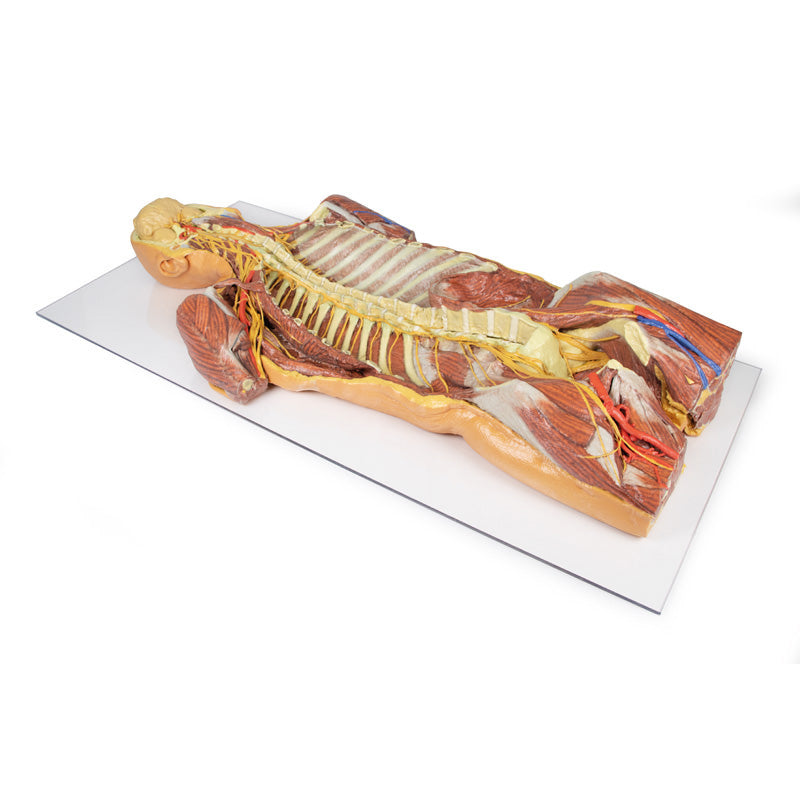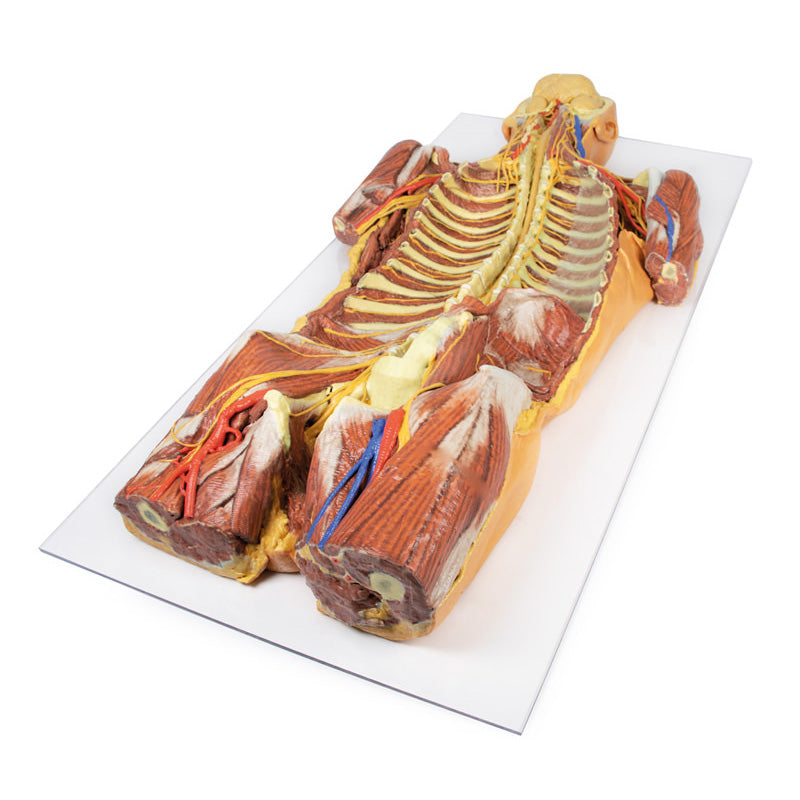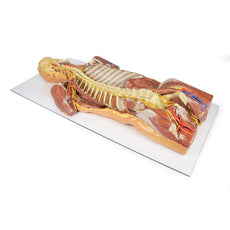Your shopping cart is empty.
3D Printed Posterior Body Wall - Ventral Deep Dissection
Inferior to the cranium, removal of the cervical vertebral bodies has exposed the course of the vertebral arteries (the right vertebral artery sectioned from C3-C5 to demonstrate ventral roots) and the anterior surface of the spinal cord, revealing the rootlets and roots of the cervical and brachial plexus; as well as the sympathetic trunks, CN X, CN XII, and the phrenic nerves. On the right side, a robust carotid nerve ascends from the superior cervical ganglion along the surface of the internal carotid artery. On the left side, part of the anterior scalene muscle and internal jugular vein have been preserved, with the internal jugular reflected posteriorly to afford a view of structures in the root of the neck. The clavicles and first ribs have been largely removed to expose the course of the axillary arteries and brachial plexus on both sides, with the removal of the anterior thoracic wall and musculature exposing both axillae and their contents. The proximal portions of both upper limbs are preserved to approximately the mid-arm, with the shoulder musculature retained (including part of the left cephalic vein in the lateral part of deltopectoral triangle).
In the midline of the thorax the spinal cord is visible to its termination at the conus medullaris, and the ventral roots and rootlets of the mixed spinal nerves are exposed and pass laterally to the terminal nerves. The sympathetic trunks are continuous from the cervical region (including the superior cervical ganglia and stellate ganglia) to the lumbar region, and across several segments the rami communicans are retained. On the right side the origin of the greater and lesser splanchnic are visible against the lateral aspects of the thoracic vertebral bodies. On the left side the intercostal nerves pass deep to the retained parietal pleura to the lumbar region, where a portion of the diaphragm is retained obscuring the origin of the subcostal nerve (though the more distal portions are visible). Inferior to the diaphragm the ilioinguinal, iliohypogastric and lateral femoral cutaneous nerves are all preserved passing laterally across the muscular posterior wall and false pelvis (e.g., quadratus lumborum, transversus abdominus, and iliacus muscles), while the genitofemoral lies on the superficial surface of the psoas muscle and the femoral nerve just lateral to it. On the right side the pleura has been completely removed and in the lumbar region the same nerves are visible, however the absence of the diaphragm and removal of the psoas muscle affords a view of the roots of the lumbar plexus and origin of femoral nerve.
The vasculature and viscera of the false and true pelvis have been completely removed excepting the termination of the rectum surrounded by the pelvic floor musculature. The lumbosacral trunk bridges the lumbar and sacral plexuses, and while most of the sacral plexus nerves are deep to the preserved obturator internus musculature, the obturator nerves are visible entering the obturator canals on both sides of the specimen. The pubic symphysis has been removed to display the longitudinal musculature of the distal rectum.
Only a small portion of the proximal thighs are retained on the specimen, but the femoral arteries and left femoral vein are retained within the femoral triangle. On the right side, removal of the sartorius muscle and dissection of the femoral triangle reveals the proximal branches of the femoral artery (medial and lateral circumflex femoral, deep artery of the thigh).
Download Handling Guidelines for 3D Printed Models
GTSimulators by Global Technologies
Erler Zimmer Authorized Dealer

16.0 lb
3D Printed Posterior Body Wall - Ventral Deep Dissection
Item # MP1410
$12,545.00
$13,939.00
You save $1,394.00
Need an estimate?
Click Add To Quote

Features & Specifications
-
by
A trusted GT partner -
FREE Shipping
U.S. Contiguous States Only -
3D Printed Model
from a real specimen -
Gov't pricing
Available upon request
About This Item
3D Printed Posterior Body Wall / Ventral Deep Dissection
This 3D printed specimen compliments our dorsal dissection specimen (MP1400) by presenting a ventral deep dissection of axial anatomy from the head, neck, axillae, thorax, and abdomen to the proximal portion of the thighs. The removal of the anterior portions of the cranium and vertebral bodies from the cervical region to the 5th lumbar provides a continuous view of the central nervous system structures and origFrequently Bought Together
3D Printed Posterior Body Wall / Ventral Deep Dissection
This 3D printed specimen compliments our dorsal dissection specimen (MP1400) by presenting a ventral deep dissection of axial anatomy from the head, neck, axillae, thorax, and abdomen to the proximal portion of the thighs. The removal of the anterior portions of the cranium and vertebral bodies from the cervical region to the 5th lumbar provides a continuous view of the central nervous system structures and origin of the segmental nerves relative to other axillary and appendicular structures. In the cranium the entire facial skeleton has been removed (to the level of the temporal bones at the styloid processes) to expose the two cerebral hemispheres separated by a partial falx cerebri resting within the neurocranium. On the ventral surface of the brain, the posterior parts of the Circle of Willis are preserved; the vertebral, basilar, and anterior inferior cerebellar arteries are visible, as are the two labyrinthine arteries. The right internal carotid artery is exposed within the dissected temporal bone, reappearing deep to a small flap of dura mater before re-emerging lateral to the pituitary gland. On either side of the pituitary gland the stumps of CN II, III, V, and VI are preserved.Inferior to the cranium, removal of the cervical vertebral bodies has exposed the course of the vertebral arteries (the right vertebral artery sectioned from C3-C5 to demonstrate ventral roots) and the anterior surface of the spinal cord, revealing the rootlets and roots of the cervical and brachial plexus; as well as the sympathetic trunks, CN X, CN XII, and the phrenic nerves. On the right side, a robust carotid nerve ascends from the superior cervical ganglion along the surface of the internal carotid artery. On the left side, part of the anterior scalene muscle and internal jugular vein have been preserved, with the internal jugular reflected posteriorly to afford a view of structures in the root of the neck. The clavicles and first ribs have been largely removed to expose the course of the axillary arteries and brachial plexus on both sides, with the removal of the anterior thoracic wall and musculature exposing both axillae and their contents. The proximal portions of both upper limbs are preserved to approximately the mid-arm, with the shoulder musculature retained (including part of the left cephalic vein in the lateral part of deltopectoral triangle).
In the midline of the thorax the spinal cord is visible to its termination at the conus medullaris, and the ventral roots and rootlets of the mixed spinal nerves are exposed and pass laterally to the terminal nerves. The sympathetic trunks are continuous from the cervical region (including the superior cervical ganglia and stellate ganglia) to the lumbar region, and across several segments the rami communicans are retained. On the right side the origin of the greater and lesser splanchnic are visible against the lateral aspects of the thoracic vertebral bodies. On the left side the intercostal nerves pass deep to the retained parietal pleura to the lumbar region, where a portion of the diaphragm is retained obscuring the origin of the subcostal nerve (though the more distal portions are visible). Inferior to the diaphragm the ilioinguinal, iliohypogastric and lateral femoral cutaneous nerves are all preserved passing laterally across the muscular posterior wall and false pelvis (e.g., quadratus lumborum, transversus abdominus, and iliacus muscles), while the genitofemoral lies on the superficial surface of the psoas muscle and the femoral nerve just lateral to it. On the right side the pleura has been completely removed and in the lumbar region the same nerves are visible, however the absence of the diaphragm and removal of the psoas muscle affords a view of the roots of the lumbar plexus and origin of femoral nerve.
The vasculature and viscera of the false and true pelvis have been completely removed excepting the termination of the rectum surrounded by the pelvic floor musculature. The lumbosacral trunk bridges the lumbar and sacral plexuses, and while most of the sacral plexus nerves are deep to the preserved obturator internus musculature, the obturator nerves are visible entering the obturator canals on both sides of the specimen. The pubic symphysis has been removed to display the longitudinal musculature of the distal rectum.
Only a small portion of the proximal thighs are retained on the specimen, but the femoral arteries and left femoral vein are retained within the femoral triangle. On the right side, removal of the sartorius muscle and dissection of the femoral triangle reveals the proximal branches of the femoral artery (medial and lateral circumflex femoral, deep artery of the thigh).
Download Handling Guidelines for 3D Printed Models
GTSimulators by Global Technologies
Erler Zimmer Authorized Dealer

by — Item # MP1410
3D Printed Posterior Body Wall - Ventral Deep Dissection
$12,545.00
$13,939.00
Add to Cart
Add to Quote












































































